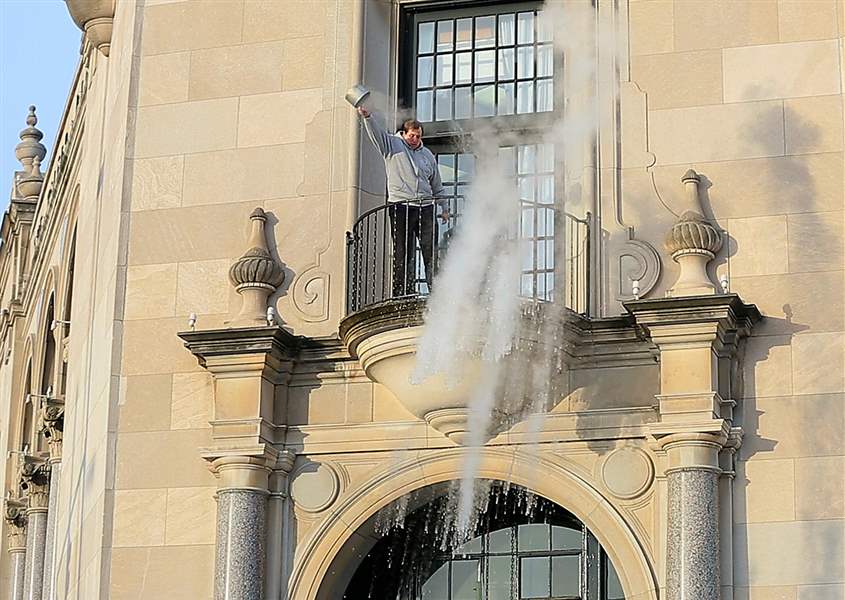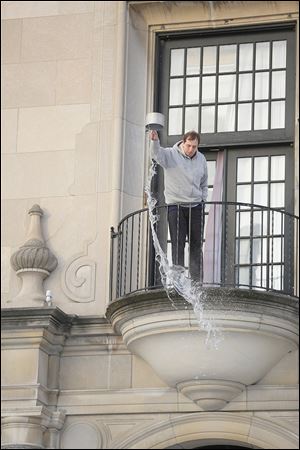
Blade staffer changes hot water into slush
Conclusion: It needs to be colder
1/23/2014
Staff writer David Patch hurls a pot of near-boiling water from the balcony outside a third-floor Blade office while the temperature outdoors hovered at about -3 degrees Wednesday morning.
THE BLADE/AMY E. VOIGT
Buy This Image

Staff writer David Patch hurls a pot of near-boiling water from the balcony outside a third-floor Blade office while the temperature outdoors hovered at about -3 degrees Wednesday morning.
Staff writer David Patch tested the reaction of cold and hot water in below-freezing temperatures. He conducted the experiment at The Blade building.
Like a lot of people this winter, I’ve heard about the “turn boiling water to snow” experiment.
I even tried it at my house on the night it got down to -15. Unfortunately, it was dark and windy out, so I couldn’t really see the results when I made my toss because my boiling-water pot’s contents blew immediately into my neighbor’s yard. Furthermore, I did it at ground level, because none of my second-story windows was appropriate for the experiment.
The Blade, on the other hand, has a handy third-floor balcony that is perfect for this little bit of home science, as long as there’s also a supply of rock salt available to tame the icy mess on the sidewalk below from the “control” test using plain, old cold water.
So that’s where we went when it got cold again Wednesday morning. The only problem here was we didn’t have a stove, and heating up a sufficient amount of hot water was very slow in the microwave.
Fresh-from-the-tap cold water fell straight to the ground and froze, as expected. Then I tried some hot tap water, which was about 120 degrees. It made some steam, but it mostly splattered to the sidewalk too.
While this was going on, one of our maintenance folks brought up some water he said had heated to about 150 degrees, but it still didn’t make the puff of ice crystals that I expected when I heaved it over the side.
So he fetched a microwave-safe bowl, and we heated water in that up to about 185 before pouring it into my spaghetti pot, which I used for its long handle. That amount of heating took about 10 minutes, and our photographer was getting cold out there in the -3 chill, so we just went with that rather than try to push any higher.
At that temperature, we got some pretty decent results, though from above it still didn’t look completely like snow. Maybe falling slush or something. But the difference is still pretty striking.
How does it work?

Cold water thrown into the air doesn’t have nearly the drama-tic effect that hot water does.
According to LiveScience: “Colder air holds less water vapor than warmer air, while the boiling water is giving off lots of water vapor. ... When the hot water is thrown into the cold air, the air gets more water vapor than it can hold, Mark Seeley, a climatologist at the University of Minnesota, explained previously to LiveScience’s Life’s Little Mysteries, so the water vapor clings to tiny particles in the air, crystallizing into snow.”
The cold water just falls to the ground and freezes there, because it doesn’t have any vapor.
Mr. Seeley told LiveScience the experiment works best if the temperature is -30 Fahrenheit or colder. Our attempt much closer to zero may have been a bigger reason why we didn’t get a real puff of ice crystals, like one sees on the Web, than with our inability to get the water up to boiling.
In any case, be very careful if you try this at home. I used a long-handled pot for a reason: to keep the very-hot, if not actually scalding, water away from my hands. I probably should have worn gloves too.
And make sure that when you heave that hot water up in the air, any wind is blowing away from you and anyone who’s watching. A calm morning like Wednesday’s is ideal.
Forecasters expect Toledo to have a few more subzero mornings during the upcoming week. As of Wednesday afternoon, the National Weather Service predicted -4 on Friday morning and -8 on Tuesday morning. If you want to hold out for -30, you’ll probably need to go to Minnesota, northern Ontario, or someplace else that gets colder than Toledo does.
Toledo’s all-time record here is -20, and the -15 we had on the evening of Jan. 6 was the 10th coldest temperature ever measured here — so getting even to the midminus-teens here is rare.
Contact David Patch at: dpatch@theblade.com or 419-724-6094.